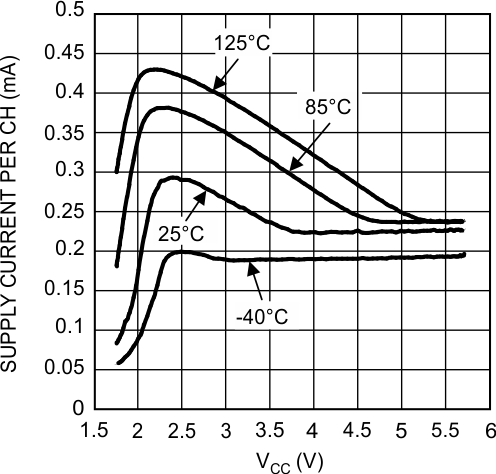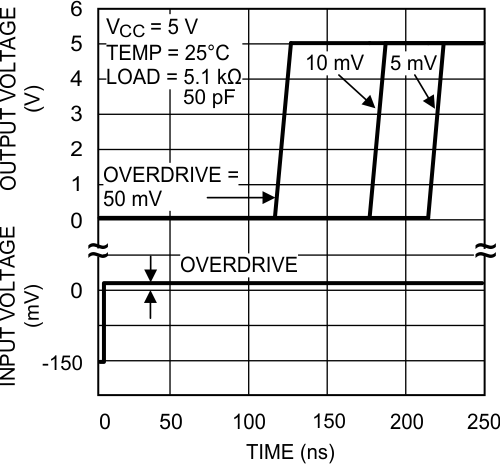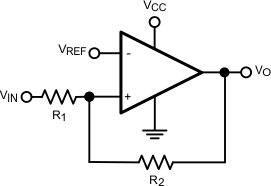-
LMV76x and LMV762Q-Q1 Low-Voltage, Precision Comparator With Push-Pull Output
- 1 Features
- 2 Applications
- 3 Description
- 4 Revision History
- 5 Pin Configuration and Functions
-
6 Specifications
- 6.1 Absolute Maximum Ratings
- 6.2 ESD Ratings: LMV761, LMV762
- 6.3 ESD Ratings: LMV762Q-Q1
- 6.4 Recommended Operating Conditions
- 6.5 Thermal Information
- 6.6 2.7-V Electrical Characteristics
- 6.7 5-V Electrical Characteristics
- 6.8 2-V Switching Characteristics
- 6.9 5-V Switching Characteristics
- 6.10 Typical Characteristics
- 7 Detailed Description
- 8 Application and Implementation
- 9 Power Supply Recommendations
- 10Layout
- 11Device and Documentation Support
- 12Mechanical, Packaging, and Orderable Information
- IMPORTANT NOTICE
Package Options
Mechanical Data (Package|Pins)
Thermal pad, mechanical data (Package|Pins)
Orderable Information
LMV76x and LMV762Q-Q1 Low-Voltage, Precision Comparator With Push-Pull Output
1 Features
- VS = 5 V, TA = 25°C, Typical Values Unless Specified
- Input Offset Voltage 0.2 mV
- Input Offset Voltage (Maximum Over Temp) 1 mV
- Input Bias Current 0.2 pA
- Propagation Delay (OD = 50 mV) 120 ns
- Low Supply Current 300 μA
- CMRR 100 dB
- PSRR 110 dB
- Extended Temperature Range −40°C to +125°C
- Push-Pull Output
- Ideal for 2.7-V and 5-V Single-Supply Applications
- Available in Space-Saving Packages:
- 6-Pin SOT-23 (Single With Shutdown)
- 8-Pin SOIC (Single With Shutdown)
- 8-Pin SOIC and VSSOP (Dual Without Shutdown)
- LMV762Q-Q1 is Qualified for Automotive Applications
- AEC-Q100 Qualified With the Following Results:
- Device Temperature Grade 1: –40°C to +125°C Ambient Operating Temperature Range
- Device HBM ESD Classification Level 1C
- Device CDM ESD Classification Level M2
2 Applications
- Portable and Battery-Powered Systems
- Scanners
- Set-Top Boxes
- High-Speed Differential Line Receiver
- Window Comparators
- Zero-Crossing Detectors
- High-Speed Sampling Circuits
- Automotive
3 Description
The LMV76x devices are precision comparators intended for applications requiring low noise and low input offset voltage. The LMV761 single has a shutdown pin that can be used to disable the device and reduce the supply current. The LMV761 is available in a space-saving 6-pin SOT-23 or 8-Pin SOIC package. The LMV762 dual is available in 8-pin SOIC or VSSOP package. The LMV762Q-Q1 is available VSSOP and SOIC packages.
These devices feature a CMOS input and push-pull output stage. The push-pull output stage eliminates the need for an external pullup resistor.
The LMV76x are designed to meet the demands of small size, low power and high performance required by portable and battery-operated electronics.
The input offset voltage has a typical value of 200 μV at room temperature and a 1-mV limit over temperature.
Device Information(1)
| PART NUMBER | PACKAGE | BODY SIZE (NOM) |
|---|---|---|
| LMV761 | SOIC (8) | 4.90 mm × 3.91 mm |
| SOT-23 (6) | 2.90 mm × 1.60 mm | |
| LMV762 LMV762Q-Q1 |
SOIC (8) | 4.90 mm × 3.91 mm |
| VSSOP (8) | 3.00 mm × 3.00 mm |
- For all available packages, see the orderable addendum at the end of the data sheet.
Threshold Detector

VOS vs VCC

4 Revision History
Changes from H Revision (March 2013) to I Revision
- Added Pin Configuration and Functions section, ESD Ratings table, Feature Description section, Device Functional Modes, Application and Implementation section, Power Supply Recommendations section, Layout section, Device and Documentation Support section, and Mechanical, Packaging, and Orderable Information section Go
Changes from G Revision (March 2013) to H Revision
- Changed layout of National Data Sheet to TI formatGo
5 Pin Configuration and Functions

Pin Functions for SOT-23
| PIN | TYPE | DESCRIPTION | |
|---|---|---|---|
| NO. | NAME | ||
| 1 | +IN | I | Noninverting input |
| 2 | V- | P | Negative power terminal |
| 3 | -IN | I | Inverting input |
| 4 | OUT | O | Output |
| 5 | SDB | I | Shutdown (active low) |
| 6 | V+ | P | Positive power terminal |

Pin Functions for SOIC (Single)
| PIN | TYPE | DESCRIPTION | |
|---|---|---|---|
| NO. | NAME | ||
| 1 | N/C | — | No Connect (not internally connected) |
| 2 | -IN | I | Inverting Input |
| 3 | +IN | I | Noninverting Input |
| 4 | V- | P | Negative Power Terminal |
| 5 | SDB | I | Shutdown (active low) |
| 6 | OUT | O | Output |
| 7 | V+ | P | Positive Power Terminal |
| 8 | N/C | — | No Connect (not internally connected) |

Pin Functions for SOIC and VSSOP (Dual)
| PIN | TYPE | DESCRIPTION | |
|---|---|---|---|
| NO. | NAME | ||
| 1 | OUTA | O | Channel A Output |
| 2 | -INA | I | Channel A Inverting Input |
| 3 | +INA | I | Channel A Noninverting Input |
| 4 | V- | P | Negative Power Terminal |
| 5 | +INB | I | Channel B Noninverting Input |
| 6 | -INB | I | Channel B Inverting Input |
| 7 | OUTB | O | Channel B Output |
| 8 | V+ | P | Positive Power Terminal |
6 Specifications
6.1 Absolute Maximum Ratings
See (1)(2)| MIN | MAX | UNIT | ||
|---|---|---|---|---|
| Supply voltage (V+ – V−) | 5.5 | V | ||
| Differential input voltage | Supply Voltage | |||
| Voltage between any two pins | Supply Voltage | |||
| Output short circuit duration(3) | Current at input pin | ±5 | mA | |
| Soldering information | Infrared or convection (20 sec.) | 235 | °C | |
| Wave soldering (10 sec.) (Lead temp) | 260 | °C | ||
| Junction temperature | 150 | °C | ||
| Storage temperature, Tstg | −65 | 150 | °C | |
6.2 ESD Ratings: LMV761, LMV762
| VALUE | UNIT | |||
|---|---|---|---|---|
| V(ESD) | Electrostatic discharge(2) | Human body model (HBM), per ANSI/ESDA/JEDEC JS-001(1) | ± 2000 | V |
| Machine model | ± 200 | |||
6.3 ESD Ratings: LMV762Q-Q1
| VALUE | UNIT | |||
|---|---|---|---|---|
| V(ESD) | Electrostatic discharge | Human-body model (HBM), per AEC Q100-002(1) | ± 2000 | V |
| Machine model | ± 200 | |||
6.4 Recommended Operating Conditions
| MIN | MAX | UNIT | ||
|---|---|---|---|---|
| Supply voltage (V+ – V−) | 2.7 | 5.25 | V | |
| Temperature range | −40 | 125 | °C | |
6.5 Thermal Information
| THERMAL METRIC(1) | LMV761 | LMV762, LMV762Q-Q1 | UNIT | ||
|---|---|---|---|---|---|
| D (SOIC) | DBV (SOT-23) | DGK (VSSOP) | |||
| 8 PINS | 6 PINS | 8 PINS | |||
| RθJA | Junction-to-ambient thermal resistance (2) | 190 | 265 | 235 | °C/W |
6.6 2.7-V Electrical Characteristics
Unless otherwise specified, all limited ensured for TJ = 25°C, VCM = V+ / 2, V+ = 2.7 V, V− = 0 V−.| PARAMETER | TEST CONDITIONS | MIN(4) | TYP(3) | MAX(4) | UNIT | ||
|---|---|---|---|---|---|---|---|
| VOS | Input offset voltage | 0.2 | mV | ||||
| apply at the temperature extremes(2) | 1 | ||||||
| IB | Input bias current(5) | 0.2 | 50 | pA | |||
| IOS | Input offset current(5) | 0.001 | 5 | pA | |||
| CMRR | Common-mode rejection ratio | 0 V < VCM < VCC – 1.3 V | 80 | 100 | dB | ||
| PSRR | Power supply rejection ratio | V+ = 2.7 V to 5 V | 80 | 110 | dB | ||
| CMVR | Input common-mode voltage range | CMRR > 50 dB | apply at the temperature extremes(2) | −0.3 | 1.5 | V | |
| VO | Output swing high | IL = 2 mA, VID = 200 mV | V+ – 0.35 | V+ – 0.1 | V | ||
| Output swing low | IL = −2 mA, VID = –200 mV | 90 | 250 | mV | |||
| ISC | Output short circuit current(1) | Sourcing, VO = 1.35 V, VID = 200 mV | 6 | 20 | mA | ||
| Sinking, VO = 1.35 V, VID = –200 mV | 6 | 15 | |||||
| IS | Supply current LMV761 (single comparator) | 275 | 700 | μA | |||
| LMV762, LMV762Q-Q1 (both comparators) | 550 | μA | |||||
| apply at the temperature extremes(2) | 1400 | ||||||
| IOUT LEAKAGE | Output leakage I at shutdown | SD = GND, VO = 2.7 V | 0.2 | μA | |||
| IS LEAKAGE | Supply leakage I at shutdown | SD = GND, VCC = 2.7 V | 0.2 | 2 | μA | ||
6.7 5-V Electrical Characteristics
Unless otherwise specified, all limited ensured for TJ = 25°C, VCM = V+ / 2, V+ = 5 V, V− = 0 V−.| PARAMETER | TEST CONDITIONS | MIN(4) | TYP(3) | MAX(4) | UNIT | ||
|---|---|---|---|---|---|---|---|
| VOS | Input offset voltage | 0.2 | mV | ||||
| apply at the temperature extremes(2) | 1 | ||||||
| IB | Input bias current(5) | 0.2 | 50 | pA | |||
| IOS | Input offset current(5) | 0.01 | 5 | pA | |||
| CMRR | Common-mode rejection ratio | 0 V < VCM < VCC – 1.3 V | 80 | 100 | dB | ||
| PSRR | Power supply rejection ratio | V+ = 2.7 V to 5 V | 80 | 110 | dB | ||
| CMVR | Input common-mode voltage range | CMRR > 50 dB | apply at the temperature extremes(2) | −0.3 | 3.8 | V | |
| VO | Output swing high | IL = 4 mA, VID = 200 mV | V+ – 0.35 | V+ – 0.1 | V | ||
| Output swing low | IL = –4 mA, VID = –200 mV | 120 | 250 | mV | |||
| ISC | Output short circuit current(1) | Sourcing, VO = 2.5 V, VID = 200 mV | 6 | 60 | mA | ||
| Sinking, VO = 2.5 V, VID = −200 mV | 6 | 40 | |||||
| IS | Supply current LMV761 (single comparator) | 225 | 700 | μA | |||
| LMV762, LMV762Q-Q1 (both comparators) | 450 | μA | |||||
| apply at the temperature extremes(2) | 1400 | ||||||
| IOUT LEAKAGE | Output leakage I at shutdown | SD = GND, VO = 5 V | 0.2 | μA | |||
| IS LEAKAGE | Supply leakage I at shutdown | SD = GND, VCC = 5 V | 0.2 | 2 | μA | ||
6.8 2-V Switching Characteristics
over operating free-air temperature range (unless otherwise noted)| PARAMETER | TEST CONDITIONS | MIN | TYP | MAX | UNIT | |
|---|---|---|---|---|---|---|
| tPD | Propagation delay RL = 5.1 kΩ CL = 50 pF |
Overdrive = 5 mV | 270 | ns | ||
| Overdrive = 10 mV | 205 | |||||
| Overdrive = 50 mV | 120 | |||||
| tSKEW | Propagation delay skew | 5 | ns | |||
| tr | Output rise time | 10% to 90% | 1.7 | ns | ||
| tf | Output fall time | 90% to 10% | 1.8 | ns | ||
| ton | Turnon time from shutdown | 6 | μs | |||
6.9 5-V Switching Characteristics
over operating free-air temperature range (unless otherwise noted)| PARAMETER | TEST CONDITIONS | MIN | TYP | MAX | UNIT | |
|---|---|---|---|---|---|---|
| tPD | Propagation delay RL = 5.1 kΩ CL = 50 pF |
Overdrive = 5 mV | 225 | ns | ||
| Overdrive = 10 mV | 190 | |||||
| Overdrive = 50 mV | 120 | |||||
| tSKEW | Propagation delay skew | 5 | ns | |||
| tr | Output rise time | 10% to 90% | 1.7 | ns | ||
| tf | Output fall time | 90% to 10% | 1.5 | ns | ||
| ton | Turnon time from shutdown | 4 | μs | |||
6.10 Typical Characteristics

| VO = High | |||||









| VO = Low |








7 Detailed Description
7.1 Overview
The LMV76x family of precision comparators is available in a variety of packages and is ideal for portable and battery-operated electronics.
To minimize external components, the LMV76x family features a push-pull output stage where the output levels are power-supply determined. In addition, the LMV761 (single) features an active-low shutdown pin that can be used to disable the device and reduce the supply current.
7.2 Functional Block Diagram

7.3 Feature Description
7.3.1 Basic Comparator
A basic comparator circuit is used to convert analog input signals to digital output signals. The comparator compares an input voltage (VIN) at the noninverting input to the reference voltage (VREF) at the inverting pin. If VIN is less than VREF the output (VO) is low (VOL). However, if VIN is greater than VREF, the output voltage (VO) is high (VOH).
 Figure 19. Basic Comparator Without Hysteresis
Figure 19. Basic Comparator Without Hysteresis
 Figure 20. Basic Comparator
Figure 20. Basic Comparator
7.3.2 Hysteresis
The basic comparator configuration may oscillate or produce a noisy output if the applied differential input is near the input offset voltage of the comparator, which tends to occur when the voltage on one input is equal or very close to the other input voltage. Adding hysteresis can prevent this problem. Hysteresis creates two switching thresholds (one for the rising input voltage and the other for the falling input voltage). Hysteresis is the voltage difference between the two switching thresholds. When both inputs are nearly equal, hysteresis causes one input to effectively move quickly past the other. Thus, moving the input out of the region in which oscillation may occur.
Hysteresis can easily be added to a comparator in a noninverting configuration with two resistors and positive feedback Figure 22. The output will switch from low to high when VIN rises up to VIN1, where VIN1 is calculated by Equation 1:
The output will switch from high to low when VIN falls to VIN2, where VIN2 is calculated by Equation 2:
The Hysteresis is the difference between VIN1 and VIN2, as calculated by Equation 3:
 Figure 21. Basic Comparator With Hysteresis
Figure 21. Basic Comparator With Hysteresis
 Figure 22. Noninverting Comparator Configuration
Figure 22. Noninverting Comparator Configuration
7.3.3 Input
The LMV76x devices have near-zero input bias current, which allows very high resistance circuits to be used without any concern for matching input resistances. This near-zero input bias also allows the use of very small capacitors in R-C type timing circuits. This reduces the cost of the capacitors and amount of board space used.
7.4 Device Functional Modes
7.4.1 Shutdown Mode
The LMV761 features a low-power shutdown pin that is activated by driving SD low. In shutdown mode, the output is in a high-impedance state, supply current is reduced to 20 nA and the comparator is disabled. Driving SD high will turn the comparator on. The SD pin must not be left unconnected due to the fact that it is a high-impedance input. When left unconnected, the output will be at an unknown voltage. Do not three-state the SD pin.
The maximum input voltage for SD is 5.5 V referred to ground and is not limited by VCC. This allows the use of
5-V logic to drive SD while VCC operates at a lower voltage, such as 3 V. The logic threshold limits for SD are proportional to VCC.